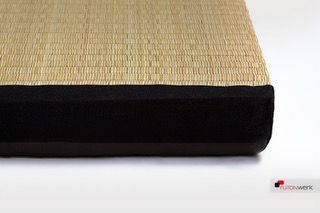Collection: Tatami
The symbol for the Japanese style of living
Tatamis are insulating and cushioning mats made of rice straw that are a few centimeters thick. By Japanese tradition tatami mats are used as flooring. On these a futon is rolled out to sleep on the floor. During the day the futon is rolled up again and stored in a cupboard for example. That way tatamis can be an alternative to beds, since a futon mattress can lay on them. Since the highly compacted rice straw mats don't offer ventilation, the mattresses need to be turned over regularly.
-
Tatami (HQ)
Regular price From €109,00 EURRegular priceUnit price / per
What are tatami mats made of?
Tatami mats are made of the natural materials straw and grass. The core of the tatami mat is rice straw, onto which a rush mat is fixed with cotton bands sewn on the sides.
In Japan, the flutter rush is used for this purpose (jap. Igusa). A tatami mat is usually 4.5 cm thick (standard pressing) or 5.5 cm (HQ/High Quality).
How are tatami made?
- In the first step, the core of the tatami mat is pressed from several layers of rice straw. The core of the mat is called Tatami-Doko.
- Next, a rush mat tied from Igusa grass is wrapped around the rice straw core, the so-called Tatami-Omote.
- Afterward, the edges of the tatami mat are bordered with a textile band, which is called Tatami-Beri.
The use of tatamis
Traditional use
Originally Tatamis served the nobility as sleeping and sitting underlay. Then later, entire living rooms were lined with the rice straw mats.
Today, the type of traditional interior decoration is no longer so widespread, but in many Japanese homes there is still at least one room, which is laid out with tatami mats.
For martial arts as floor mats
Tatami mats are also used in Japanese martial arts, such as in judo or karate.
Especially the 5.5cm thick mats are used to cushion throws and falling techniques.
As underlay for a futon
There are two options to use tatami as a underlay for a futon:
- A futon (like a TWIN FUTON) lying on tatami mats lets you sleep close to the floor.
- A tatami bed places the mats on slats or a wooden substructure of the bed frame.
How are tatamis maintained?
With the right care, you will enjoy your tatami for many years. Tatamis should of course be stored in a dry place, as the mats are made from natural raw materials. That means they can vary in color, become desaturated with time and have a natural odor, that reminds of straw and hay. The rice straw mats are quite sensitive to friction and therefore shouldn't be walked on with shoes.
The mats are also reacting very sensitive to loads with small contact surfaces, which is why one should only choose furniture that can distribute its weight over a large area. Also make sure that the room you are placing your tatami in is suficciently ventilated. Otherwise foxing or mold spots may form on the mats if they are laid in a room where condensation moisture builds up. (like basement apartments)
1. Unpacking
when the tatami mats arrive, they need a few days to air out after unpacking, preferably at room temperature. A natural smell escapes during this, that is not harmful, but strong. Alltogether the smell dissipates after a few weeks.
2. Cleaning
The tatami mats can be vacuumed with a vacuum cleaner at the lowest level, preferably with the cushion attachment. If it has a few stains, the mats can be carefully wiped partially damp cloth. Afterward, it must be ensured that they can dry completely before you step on them again or put a futon on them...
3. Ventilating
Tatamis themself should get stood upright every half year to air out. If the tatami is used as a base for a futon mattress, the futon should ideally be rolled / folded up daily to allow the moisture that forms at night due to heat and sweat to dry off.
4. Drying
As soon as the sun shines in spring and the temperature rises, the mats can be placed outside for a few hours to air them. This way the suns uv-light can kill most germs and bacteria on the rice straw mats.

